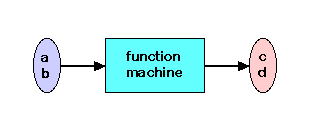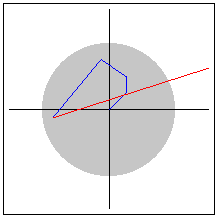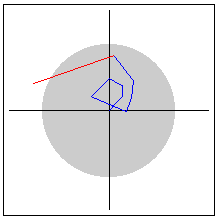What is Two Variable Function Pump?
This activity allows the user to step through plotting a two-variable function, and to judge whether a given starting point is a prisoner or an escapee, in order to understand complex numbers and Julia sets.
To understand Julia sets and ultimately the Mandelbrot set -- the world's most famous fractal -- we need to be able to calculate with and plot quadratic functions of complex numbers. The easiest way to think of complex numbers is as an ordered pair of numbers. Functions of these numbers can be described as "input-output machines" as usual, only this time an ordered pair goes in and an ordered pair comes out.

Basic Operations are revised for this new situation as:
| Addition of two pairs (+) | Component-wise, i.e., (a,b) + (c,d) = (a+c,b+d) |
| Subtraction of two pairs (-) | Component-wise, i.e., (a,b) - (c,d) = (a-c,b-d) |
| Multiplication by a number (*) | Component-wise, i.e., x * (a,b) = (x*a,x*b) |
| Division by a number (/) | Component-wise, i.e., (a,b) / x = (a/x,b/x) |
| Squaring a number (^2) | (a,b) ^2 = (a^2 - b^2, 2ab) |
An example of a function is:
f(Z) = Z^2 + (0.5,0.5)
. We are interested in choosing a starting point, plugging it into the function to get a new
point, and then plugging that point back into the function to get another new point, and so
on. For example, we can start with the point (0,0) and plug it into the function:
f(0,0) = (0,0)^2 + (0.5,0.5) = (0,0) + (0.5,0.5)= (0.5,0.5)
f(0.5,0.5) = (0.5,0.5)^2 + (0.5,0.5) = (0,0.5) + (0.5,0.5) = (0.5,1)
f(0.5,1) = (0.5,1)^2 + (0.5,0.5) = (-0.75,1) + (0.5,0.5) = (-0.25,1.5)
f(-0.25,1.5) = (-0.25,1.5)^2 + (0.5,0.5) = (-2.1875,-0.75) + (0.5,0.5) = (-1.6875,-0.25)
f(-1.6875,-0.25) = (-1.6875,-0.25)^2 + (0.5,0.5) = (2.7852,0.84375) + (0.5,0.5) = (3.2852,1.34375)
Here is a picture:

Here the points seem to be jumping around, getting farther away from (0,0) and finally leaving the gray circle of radius 2. We can try other starting points and look at what happens in each situation. There are three things that can happen. The points can:
- Get closer and closer to 0 -- we say they approach 0. These are the prisoners.
- Get larger and larger -- we say they approach infinity. These are the escapees. We know that they are escapees if they are further away from the origin than 2 units.
- Get trapped -- these points are the boundary points between the prisoners and escapees. The set of all of these points for a function is called the Julia Set.
Julia sets are the main building blocks for the Mandelbrot set. We find the Julia sets by looking for the boundary between prisoners and escapees.
How Do I Use This Activity?
This activity allows the user to step through plotting a two-variable function, and to judge whether a given starting point is a prisoner or an escapee, in order to understand complex numbers and Julia sets.
Controls and Output
-
The boxes near the bottom of the applet are where you enter a
Starting Point and a
Constant, C, for the quadratic function
f(Z) = Z^2 + C, that you want to iterate.
- Whenever you change the Starting Point or Constant, press the Restart button to start a fresh graph with those values. Press the Next Step button to calculate the next iteration.
-
The Graph shows the path (also called the orbit) of the starting point as it is plugged into the function. The red line is the path from the previous point to the most recent one. If the orbit path goes outside the gray circle of radius 2, the starting point is guaranteed to be an escapee.

The List on the left is another way to look at the values of the function -- as ordered pairs.
Description
This activity allows the user to step through plotting a two-variable function, and to judge whether a given starting point is a prisoner or an escapee, in order to understand complex numbers and Julia sets.
This activity would work well in mixed ability groups of three to five for about forty minutes if you use the exploration questions and twenty minutes otherwise.
Place in Mathematics Curriculum
This activity can be used to:
- practice students' arithmetic skills
- practice students' point plotting skills
- introduce students to complex numbers
- motivate the notions of Julia sets, prisoners and escapees
Standards Addressed
Grade 9
-
Functions and Relationships
- The student demonstrates conceptual understanding of functions, patterns, or sequences including those represented in real-world situations.
- The student demonstrates algebraic thinking.
Grade 10
-
Functions and Relationships
- The student demonstrates conceptual understanding of functions, patterns, or sequences including those represented in real-world situations.
- The student demonstrates algebraic thinking.
Number and Quantity
-
The Complex Number System
- Perform arithmetic operations with complex numbers.
- Represent complex numbers and their operations on the complex plane.
Grades 9-12
-
Algebra
- Understand patterns, relations, and functions
-
Measurement
- Apply appropriate techniques, tools, and formulas to determine measurements
Geometry
-
Geometry and Measurement
- Competency Goal 2: The learner will use geometric and algebraic properties of figures to solve problems and write proofs.
Algebra II
-
Algebra
- Competency Goal 2: The learner will use relations and functions to solve problems.
Technical Mathematics I
-
Geometry and Measurement
- Competency Goal 2: The learner will measure and apply geometric concepts to solve problems.
Technical Mathematics II
-
Geometry and Measurement
- Competency Goal 1: The learner will use properties of geometric figures to solve problems.
Advanced Functions and Modeling
-
Algebra
- Competency Goal 2: The learner will use functions to solve problems.
Discrete Mathematics
-
Algebra
- Competency Goal 3: The learner will describe and use recursively-defined relationships to solve problems.
Integrated Mathematics III
-
Algebra
- Competency Goal 3: The learner will use relations and functions to solve problems.
-
Geometry and Measurement
- Competency Goal 2: The learner will use properties of geometric figures to solve problems.
Integrated Mathematics IV
-
Algebra
- Competency Goal 4: The learner will use relations and functions to solve problems.
Secondary
-
Algebra II
- AII.01 The student will identify field properties, axioms of equality and inequality, and properties of order that are valid for the set of real numbers and its subsets, complex numbers, and matrices.
- AII.02 The student will add, subtract, multiply, divide, and simplify rational expressions, including complex fractions.
- AII.03a The student will add, subtract, multiply, divide, and simplify radical expressions containing positive rational numbers and variables and expressions containing rational exponents.
- AII.03b The student will write radical expressions as expressions containing rational exponents and vice versa.
- AII.06 The student will select, justify, and apply a technique to solve a quadratic equation over the set of complex numbers. Graphing calculators will be used for solving and for confirming the algebraic solutions.
- AII.09 The student will find the domain, range, zeros, and inverse of a function; the value of a function for a given element in its domain; and the composition of multiple functions. Functions will include exponential, logarithmic, and those that have domains and ranges that are limited and/or discontinuous. The graphing calculator will be used as a tool to assist in investigation of functions.
- AII.15 The student will recognize the general shape of polynomial, exponential, and logarithmic functions. The graphing calculator will be used as a tool to investigate the shape and behavior of these functions.
- AII.17 The student will perform operations on complex numbers and express the results in simplest form. Simplifying results will involve using patterns of the powers of i.
- AII.1
- AII.2
- AII.3.a
- AII.3.b
- AII.6
- AII.9
- AII.15
- AII.17
Textbooks Aligned
Grade Seven
-
Accentuate the Negative
- Investigation Five: Coordinate Grids
-
Comparing and Scaling
- Investigation Four: Comparing By Finding Rates
-
Moving Straight Ahead
- Investigation One: Predicting from Patterns
- Investigation Two: Walking Rates
- Investigation Three: Exploring Lines with a Graphing Calculator
- Investigation Five: Exploring Slope
- Investigation Six: Writing an Equation for a Line
-
Variables and Patterns
- Investigation One: Variables and Coordinate Graphs
- Investigation Two: Graphing Change
- Investigation Three: Analyzing Graphs and Tables
- Investigation Four: Patterns and Rules
- Investigation Five: Using a Graphing Calculator
Grade Eight
-
Frogs, Fleas and Painted Cubes
- Investigation One: Introduction to Quadratic Relationships
- Investigation Two: Quadratic Expressions
- Investigation Three: Quadratic Patterns of Change
- Investigation Four: What Is a Quadratic Function?
- Investigation Five: Painted Cubes
-
Growing, Growing, Growing
- Investigation One: Exponential Growth
- Investigation Two: Growth Patterns
- Investigation Three: Growth Factors
- Investigation Four: Exponential Decay
-
Samples and Populations
- Investigation One: Comparing Data Sets
-
Say It with Symbols
- Investigation Four: Solving Equations
-
Thinking with Mathematical Models
- Investigation One: Linear Models
- Investigation Two: Nonlinear Models
- Investigation Three: More Nonlinear Models
- Investigation Four: A World of Patterns
Book 1
-
Module 4 - Mind Games
- Section 5: Graphing on the Coordinate Grid
- Section 5: Expressions and Equations Multiples
-
Module 6 - Comparisons and Predictions
- Section 3: Using Ratios
-
Module 7 - Wonders of the World
- Section 6: Graphing Ordered Pairs
-
Module 8 - Our Environment
- Section 2: Representing Population Data
Book 2
-
Module 2 - Search and Rescue
- Section 2: Coordinate Graphing of Integers
- Section 4: Modeling Functions
- Section 4: Graphing Functions
-
Module 5 - Recreation
- Section 2: Scatter Plots
-
Module 7 - Health and Wellness
- Section 1: Formulas and Graphs
- Section 1: Misleading Graphs
Book 3
-
Module 2 - At the Mall
- Section 1: Percent
-
Module 3 - The Mystery of Blacktail Canyon
- Section 2: Graphing Equations
-
Module 4 - Patterns and Discoveries
- Section 1: Sequences
- Section 1: Fractals
Book 1
-
Patterns in Numbers and Shapes
- Lesson 7: Gridpoint Pictures
- Lesson 8: Points, Plots, and Patterns
- Lesson 9: Payday at Planet Adventure
- Lesson 10: Sneaking Up the Line
- Lesson 12: The Will
Book 2
-
The Language of Algebra
- Lesson 5: Seeing Things Graphically
- Lesson 6: The Algebra Walk
- Lesson 7: Putting It All Together
Book 3
-
Family Portraits
- Lesson 1: Inputs and Outputs
- Lesson 4: A New Slant on Linear Functions
- Lesson 5: What's in an Equation?
- Lesson 6: The Shortest Distance Between Two Points...
Grade 8
-
Get the Most Out of It
- Word Problems with Two Unknowns
- Systems of Equations
- Graphing Lines
- Graphing Inequalities
- Graphing Hyperbolas
-
Graphing Equations
- Graphing Points and Lines
- Solving Linear Equations
- Graphing Inequalities
- Equation of a line
-
Growth
- Linear functions
- Quadratic Functions
- Cubic Functions
- Exponential Functions
- Sequences
- Growth
-
Insights into Data
- Understanding Graphs
- Gathering Data
- Bias
- Representation of Data
- Correlations
- Scatter Plots
- Box Plots
Grade 5
-
Figuring All the Angles
- Measuring Angles
- Vectors
- Rectangular Coordinates
- Polar Coordinates
-
Patterns and Symbols
- Variables
- Patterns
- Pattern Rule
-
Picturing Numbers
- Bar Graphs
- Line Graphs
- Pie Charts
- Pictographs
- Describing Data
- Using Data for Arguments
Grade 6
-
Dealing With Data
- Scatter Plots
- Box Plots
- Stem and Leaf Plot
- Histograms
- Mean, Median, Mode and Range
-
Operations
- Operations with Integers
- Plotting Points
- Coordinate Plane
-
Tracking Graphs
- Line Graphs
- Interpreting Graphs
- Looking at a Graph's global features
Grade 7
-
Decision Making
- Graphs of Data
- Constraints
- Graphing Inequalities
- Discrete Functions
-
Packages and Polygons
- Geometric Shapes
- Models
- Properties of Regular and Semi-Regular Polyhedra
-
Ups and Downs
- Increasing and Decreasing Functions
- Linear Functions
- Periodic Functions
Be Prepared to
- give implicit directions on what they are to do. For example "Today we are going to find out about prisoners, escapees, and complex numbers by using the Two-Variable Function Pump activity and it's worksheet..."
- answer the question "What is a prisoner and what is an escapee?"
- discuss complex numbers, and how to plot points